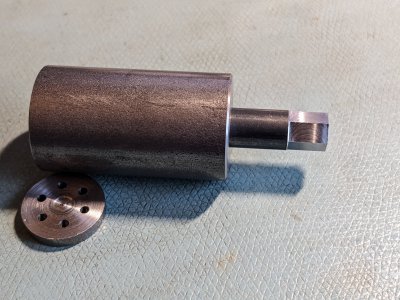- Joined
- Dec 18, 2019
- Messages
- 6,447
I'm trying to make a barrel nut for an airgun. It has an M8x1 thread. The threaded section is 10mm long, then there is about a 2mm long gutter. To avoid messing with the barrel, I made a male test piece and threaded it to M8x1, checking the thread pitch diameter with a threading micrometer. I'm right at nominal PD. I drilled the hole using a 1/4" drill then bored it to 7mm. It's not perfect, but it looks ok. I then used an Acme thread tool to (slowly) form the thread gutter between 10-12mm deep in the bore. If I believe what I did, the groove was 0.9mm deep. Finally, I single pointed the M8x1 thread using a left handed tool, with the spindle in reverse, going from the groove towards the tail stock. The compound was at -60 degrees (as opposed to +60 for normal threading).
The male test piece also has about 10mm thread and a 2mm thread gutter. I'm expecting these two pieces to mate (or nearly mate) completely, with practically no gap. But the male piece only threads in 10.2mm. At this point, it's nearly impossible to view what's in the hole. I'd need a bore camera, which I don't have. It could just be a burr at the end of the thread. It looks like the groove is deep enough, if I look through the opposite end. But maybe it isn't. I have no way to get in there to measure it. I have half ball inside measurement tools, which are not useful to measure a thread gutter.
Now maybe I could power the male piece in a little deeper. At the moment, the test male thread is on the end of a shot piece of 3/8" stress proof rod. I can't grip the rod to turn it further, so I thought I could machine a hex at the end. Looks like if I machine off 0.030" per side, I get an 8mm hex. I could use a socket wrench on the male thread to see if I could mash my way through the burr. I don't like doing that, but that's one possibility. It could mess up things though.
I could get an M8x1 tap, (check that it is ok,) then grind off the end a little and make sure the thread fully goes to the groove. I'm always leery of cheap taps though.
Worst case is to section the darn thing and find out what went wrong, which I might end up doing if I damage the thing. Besides the bore and the internal threading I don't have that much machining into this piece. I planned it this way - I didn't want to do a ton of machining only to eff it up at the end with the internal single pointing. So I did the single pointing first.
Can anyone offer a suggestion or observation that might help? The 1" female stock is 12L14, if that helps. In the end, this is what I am trying to make, but I'm a little stuck on these internal threads. It could be something obvious, that I'm missing... Wouldn't be the first time I've missed the forest from the trees!
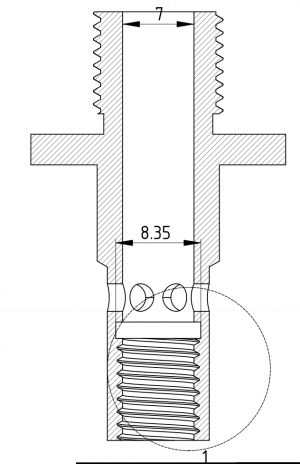
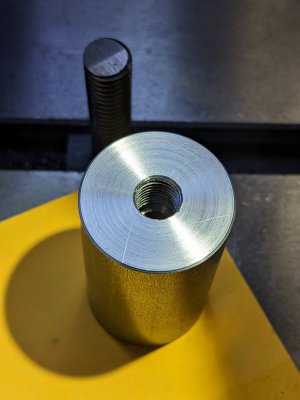
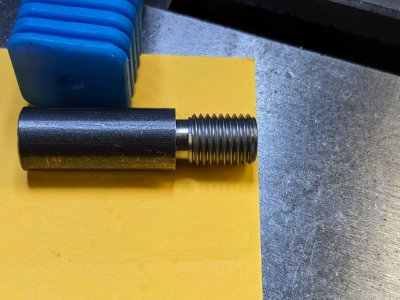
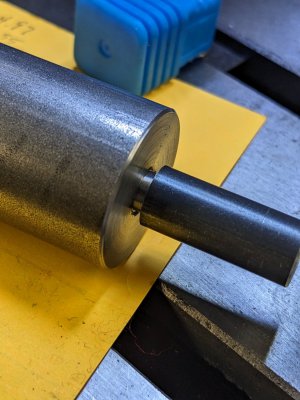
The male test piece also has about 10mm thread and a 2mm thread gutter. I'm expecting these two pieces to mate (or nearly mate) completely, with practically no gap. But the male piece only threads in 10.2mm. At this point, it's nearly impossible to view what's in the hole. I'd need a bore camera, which I don't have. It could just be a burr at the end of the thread. It looks like the groove is deep enough, if I look through the opposite end. But maybe it isn't. I have no way to get in there to measure it. I have half ball inside measurement tools, which are not useful to measure a thread gutter.
Now maybe I could power the male piece in a little deeper. At the moment, the test male thread is on the end of a shot piece of 3/8" stress proof rod. I can't grip the rod to turn it further, so I thought I could machine a hex at the end. Looks like if I machine off 0.030" per side, I get an 8mm hex. I could use a socket wrench on the male thread to see if I could mash my way through the burr. I don't like doing that, but that's one possibility. It could mess up things though.
I could get an M8x1 tap, (check that it is ok,) then grind off the end a little and make sure the thread fully goes to the groove. I'm always leery of cheap taps though.
Worst case is to section the darn thing and find out what went wrong, which I might end up doing if I damage the thing. Besides the bore and the internal threading I don't have that much machining into this piece. I planned it this way - I didn't want to do a ton of machining only to eff it up at the end with the internal single pointing. So I did the single pointing first.
Can anyone offer a suggestion or observation that might help? The 1" female stock is 12L14, if that helps. In the end, this is what I am trying to make, but I'm a little stuck on these internal threads. It could be something obvious, that I'm missing... Wouldn't be the first time I've missed the forest from the trees!






